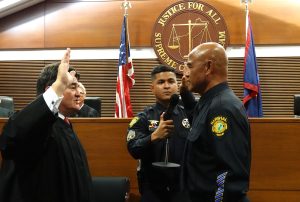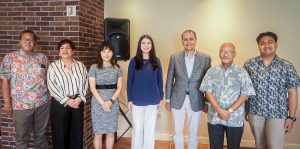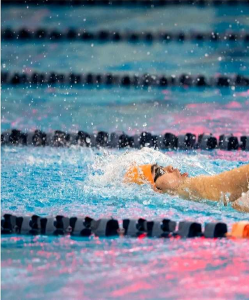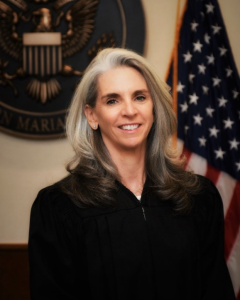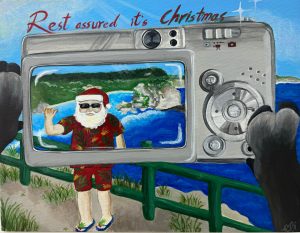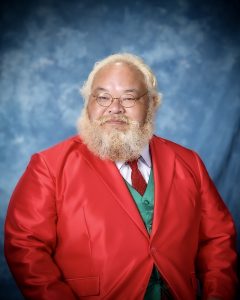Return of ancestral remains ignites community spirit
After 43 years, several Indigenous remains made the 43-hour journey back to home soil, touching down at the Francisco C. Ada/Saipan International Airport early morning Wednesday, Nov. 20.
The move was significant to many in the community, and this was evident as the Marianas diaspora in the U.S. mainland even travelled over to the University of California Riverside to conduct a sendoff ceremony for the remains, which included chants, prayers, and offering of flowers.
A similar welcome awaited the remains as members of the CNMI community made up of cultural dancers and local suruhuånu or herbal healer Donald Mendiola gathered at the airport last Wednesday. Following the dances and chants, Mendiola provided a Chamorro blessing for the ancestral remains.
NMI Museum of History and Culture director Leni Leon, along with a small CNMI delegation, including Joeten-Kiyu Public Library director Erlinda Naputi escorted and safeguarded the remains as they journeyed home.
Leon shared that the group had initially traveled to take part in the Association of Tribal Archives, Libraries, and Museums Conference in Palm Springs, California.
Leon shared with Saipan Tribune that just a couple of months prior he had received an email from Fran Lujan, a former CNMI resident of Chamorro descendant who serves as a director and curator for the Pacific Islanders Ethnic Art Museum in California.
“She was informed by the NACPRA program at the University of California, Riverside, about ancestral remains that are in their possession and have been in their possession since 1981.”
Leon said that the remains had been originally transported to UCR for radio carbon analysis, taken from three sites in the CNMI—areas within Grotto Cave area, San Antonio’s Pak Pak beach for Saipan and in Tinian, and the area near the Taga House.
He shared that upon learning this, the NMI Museum began consulting with the UCR Native American Graves Protection and Repatriation Act program, the CNMI Historic Preservation Office, Indigenous Affairs and the Carolinian Affairs Office on how they can repatriate the remains, all the while ensuring that they were in compliance, and they were taking every measure to respect cultural sensitivity, comply with the Native American Grave Protection Act, through which they were able to easily bring the remains home, as well as Section 106 of the National Historic Preservation Act of 1966.
On Nov. 16, following the conference in California, a small number of the CNMI delegation, along with Leon traveled to UCR where the handover and sendoff ceremony took place. From there, the group would start the travel with the remains ensuring its protection.
“We did our best to be very respectful. None of the ancestry remains went through a Transportation Security Administration screening. They were hand-inspected, just to avoid any radiation and whatnot”
Leon shared that the send-off and the welcoming were both equally emotional.
“That was a pretty memorial event for me to witness. There were a lot of attendees that were very emotional, I would say. The same thing happened on Saipan when we arrived, while they were conducting their dances, their welcome home prayers and ceremony chants, I could see attendees in tears. So, I don’t think it is much of a generational thing, but could potentially be an identity and a spiritual thing. Just to be able to know that their ancestors returned home and safely, I think that’s what really touched their hearts. That’s just from my observation,” said Leon.
Personally, the NMI Museum director said the event also touched him.
“It was very emotional for me, and it was a pretty heavy responsibility for me as a Marshallese, doing this and not being neither Chamorro or Carolinian. And because I’m neither, I had to make sure that I took every process possible to be very respectful and considerate of cultural sensitivity. “
Leon said that the remains will be in his office at the NMI Museum until a final resting place, near to the original resting spots can be decided. He shared that, so far, the Historic Preservation Office is working with the Tinian Mayor’s Office to identify sites for a burial site for any unearthed remains.
“So, they’re working on that. Then there is a construction going on at Pak Pak Beach right now and HPO is also working on constructing a burial site there as well. So, that is a conversation that I will need to have with HPO and hope that we can include these ancestral remains at those two sites so we can rematriate them with the others.”
According to sources from the internet, while repatriation means a literal returning to the land of your ancestry, rematriation carries a deeper meaning of returning to a way of life, one that lives with reverence for nature.
As for the Grotto site, Leon shared that he had a very promising conversation with Department of Public Lands Secretary Teresita Santos who said they’re going to help in identifying a site.
“There’s potential for designation of land for the ancestral remains. I think what makes this particular rematriation unique is that it was very community and culturally driven with cultural advisors being the performers, and suruhånu Uncle Donald Mendiola was a really big help and played a big role in making sure that we were very culturally sensitive to these ancestors.”
He also added, “I think, you know, it is important to acknowledge that it’s the work of Native American tribe, tribes in California who really made this very possible. When they created the CalNACPRA.” He said that through this program, it made the rematriation easy and they didn’t have to pay millions of dollars to bring the remains back home.
Naputi also played a part in the rematriation process and shared with Saipan Tribune her personal experience in bringing back home the ancestral remains.
“Just knowing that our loved ones were out there and I know that they were brought out with good intentions to do a study on their remains and maybe get a better understanding of their gender, their age, and other information that was needed. But I’m glad that we were able to bring them home and lay them to rest where they once laid. It’s always nice and a somber reminder that when we work together, when we work together, everything is possible. And just the beautiful ceremony, the going-away ceremony, the receiving ceremony here at the airport that we got from Francis Sablan and April Lepeki and their group and Uncle Don with his blessing and the people that were there to welcome us. It’s just was beautiful.
She also couldn’t describe in words her feeling when she first opened the container where the ancestral remains were resting for the past 40 years.
“You can feel that energy from where they were for the past 40 years. The energy and the strength that they gave us to carry forth with and bring them home. There are no words to describe the feeling that you get when you first hold them in your arms. I’d like to acknowledge and give credit to our Gov. Arnold I. Palacios, and the Lt. Gov. David M. Apatang for giving us the opportunity and allowing us the opportunity to be a part of this very historic event.”
Naputi also gave kudos to Leon for helping in the process of rematriating the ancestral remans.
” I’m of Marianas descent and it really touched me to see that, even though Leni is not of Marianas descent or an indigenous Chamorro-Carolinian, he still took the initiative to bring our people home. And with that, I thank him for leading us and guiding us in this effort. As a library director, my involvement is really to just connect people with the right institution, give them the information that they needed. And when they reached out to me a year ago, last November 2023, I could only do what I could as a director, putting them in contact with the right people. As much as I want to be the one to lead the efforts of bringing our ancestral remains, I’m not in the right position to do so. We are very fortunate and lucky to have all the support from the president of Association of Tribal Archives, Library Museum, Susan Feller, also Dr. Tarisi Vunidilo, and her husband, and the rest of our Pacific Islanders for standing with us during this time. We are forever grateful for all the support that we received while we were out there.”
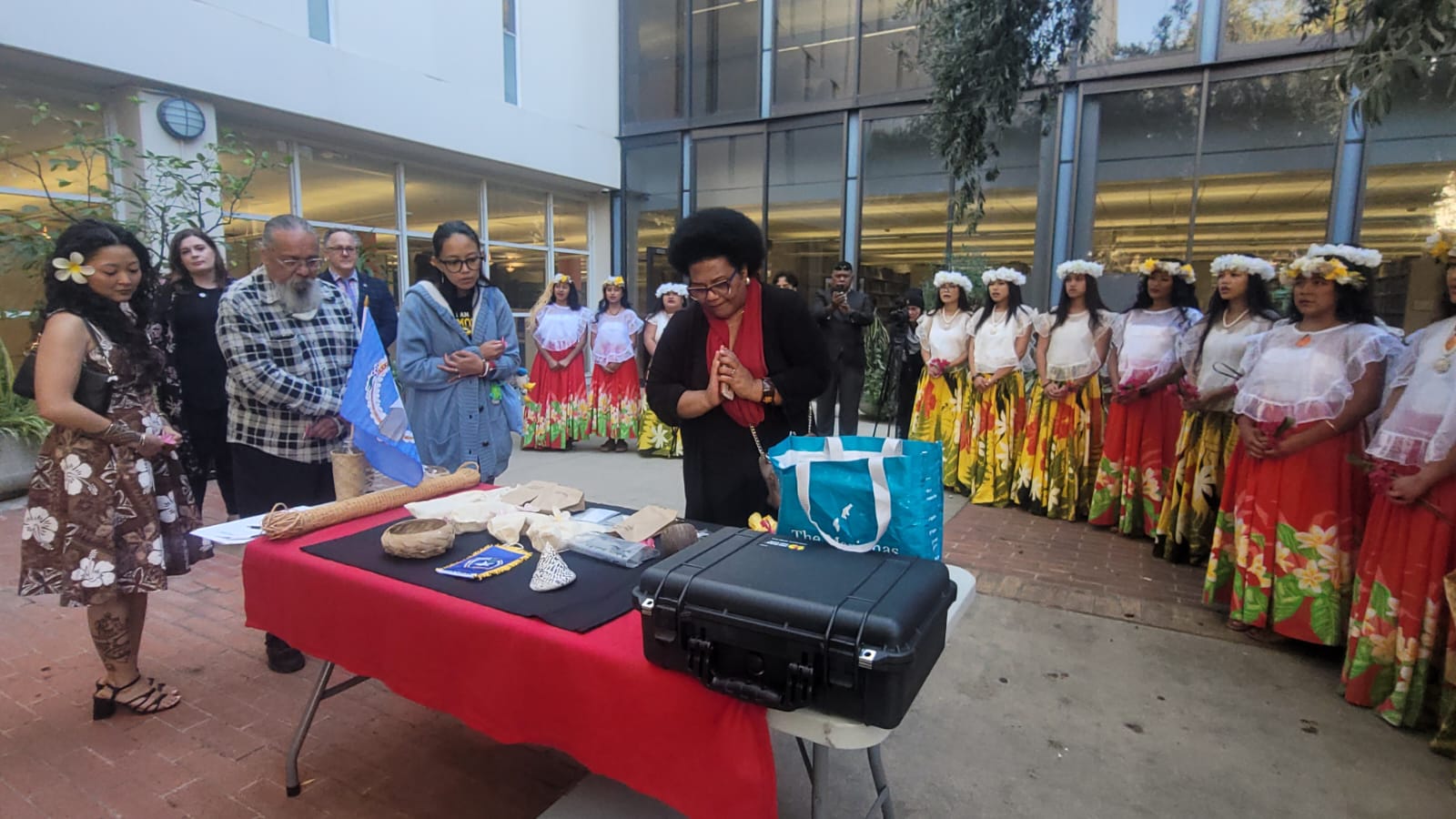
Dr. Tarisi Vunidilo, a major supporter the rematriation process of Marianas ancestral remains, pays her respects at the handover and send off ceremony on Nov. 16, 2024 at the University of California Riverside.
-CONTRIBUTED PHOTO

